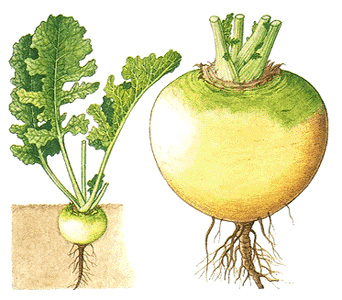Turnip is a vegetable grown mostly for its fleshy root. Turnip roots usually measure from 2 to 3 inches (5 to 8 centimeters) in diameter when harvested and weigh between 1/2 and 1 pound (225 and 450 grams). Their smooth, firm flesh may be white or light yellow. People also eat turnip leaves. These thin, hairy leaves grow on stems that can reach a height of 18 inches (46 centimeters).

Turnip roots are a good source of vitamin C, and the leaves are rich in iron and vitamin A. People may eat the roots boiled, mashed, or as fried strips. Young turnip leaves can form part of salads, soups, and stews.
Turnips are grown on farms and in home gardens throughout Europe and in Canada and the United States. Turnips thrive in cool weather, being able to withstand light frost. The plants grow quickly and are usually ready for harvest 45 to 55 days after planting. The seeds are planted in March for a spring harvest and in August or September for a fall harvest. Turnip seeds develop best in moderately dry, loose soil. Turnips require adequate fertilizer, especially those planted in the spring. Aphids, cabbage worms, and various beetle larvae are the chief pests of turnips. Once harvested, however, turnips have a long storage life.
Turnips probably originated in Asia or Europe. Ancient Greeks and Romans grew turnips and may have introduced them into northern Europe. People in England and Ireland once used turnips to make jack-o-lanterns for Halloween, before the introduction of pumpkins for that purpose. The rutabaga, a close relative of the turnip, is sometimes called a Swedish turnip.
See also Cabbage ; Kohlrabi ; Rutabaga ; Townshend, Viscount .
